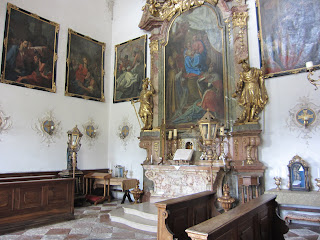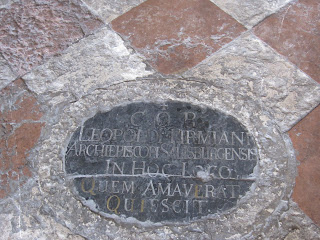I can't remember if I posted anything about the history of the schloss. I don't think so. Not as a dedicated entry, of course. I know there were hints.
It is quite interesting(and I want to use more of the library and schloss photos I took) I'm sneaky that way. :D Here's my favorite photo of the schloss exterior. Two residences of a Prince-Archbishop of Salzburg.
So bear with me while we delve into the history of Schloss Leopoldskron. First we will set the scene with a few facts about Salzburg. Salzburg means salt castle in German. Also known as 'white gold' the salt mines in the area ensured that money poured into the region. It was one of the main reasons that Salzburg became an archbishopric so early. (Before the 1000's) Some salt mines still do operate in the region to this day. If anyone is interested in the history of salt and how important it was to the world economy check out this book, Salt, a world history by Mark Kurlansky.
So early on Salzburg had enough money to be an independent principality with an Archbishop as the head of the church and the political head of state. Known as a Prince-Archbishop until the early 1800's,(Napoleon and the Council of Vienna stripped the Prince part of the title in 1815 and Salzburg officially became a part of Austria.) they were the power in Salzburg. In fact Mozart's father was court composer to Archbishop Leopold Firmian. They even think a young Mozart played in the schloss for the Archbishop. It makes some sense, there's just no documentary evidence. Young Wolfgang played everywhere else why not at Schloss Leopoldskron for his father's patron?
So back to the early history of the schloss. Leopold Firmian... umm...acquired some land near a small lake in the countryside(he expelled a lot of the Protestants of Salzburg and gee look at all that wasted farmland) and decided to build himself a summer palace.
I gotta say this for him, he knew location. His plot of land was right between the Untersberg mountain and the city with great views of both, depending on which way you were facing. And as an added bonus it's waterfront property!
So the palace had to match both the location and the importance of the owner. As you can imagine, it took him quite some time to get exactly what he wanted.
He started it in 1736 and it was finished in 1744(right before he died) In keeping with artistic trends of the time he did it in the Baroque/rococo style. Lots of stucco work, marble, and giltwork. That man had no self-esteem issues whatsoever. Anyone who makes the Pope gasp at your audacity has a HUGE ego. (That was the whole expelling the Protestants deal.)
Here's some views of the original Baroque style. The chapel is one of 2 rooms left as Baroque.
After he died he had to have his body interred in the Dom. As the Archbishop of Salzburg he had a reserved spot in the Dom crypt whether he wanted it or not. In the 18th century, however, it was trendy to bury part of yourself in places you loved or had meaning for you. So Leopold Firmian literally left his heart at Schloss Leopoldskron. In the chapel floor actually.
He left the place that he loved to his nephew, Count Laktans, who sadly did not pass it on to family upon his death.
A shooting gallery owner acquired the place when the Count died and sold off most of the pretty things like paintings, giltwork, and statues that the count and archbishop had collected. The Firmans were known as patrons of the arts. Apparently the shooting gallery owner was not. They don't know for sure if the schloss was used as a shooting gallery, but I wouldn't be surprised. Guys, guns, and money in the 19th century. You can do the math.
The shooting gallery owner didn't own it for very long. It was sold several times in the 19th century and used for different purposes.
So now we wait for the entrance of the 20th century and Max Reinhardt.
Friday, July 29, 2011
Subscribe to:
Post Comments (Atom)






No comments:
Post a Comment